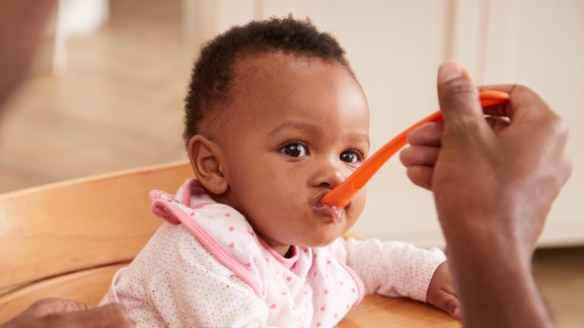Comparing Methods & Benefits of Complementary Feeding
1 min read • By: Gerber Medical Hub

Quick summary
All complementary feeding methods share some common benefits that are not exclusive to one method. Examples of benefits across methods are dietary variety and the opportunity for parents and caregivers to practice responsive feeding. Below are highlighted select benefits that have been documented in the literature for each type of method. Note that if a benefit is not listed, it is likely due to lack of data or absence from the literature and the need for further research.
Spoon-Feeding
Spoon-Feeding has many benefits such as
- food and nutrient intake (Pearce 2022, Rowan 2022),
- food group exposure (Pearce 2022, Rowan 2019), and
- more complex gut microbiota due to ingestion of a more varied diet (Leong 2014).
Baby-Led Weaning (BLW)
BLW is a relatively recent approach with primarily self-reported benefits and associations in the literature:
- exposure to a varied diet (Bialek-Dratwa 2022),
- food preferences (Townsend 2012),
- estimated energy intake similar to spoon-feeding based upon diet diaries (Rowan 2022),
- more involved in family mealtimes (Webber 2021), greater satiety responsiveness (Brown 2015),
- positive family dynamics and practices (Brown 2011),
- less food fussiness (Fu 2018),
- increased vegetable exposure (Rowan 2019),
- and caregivers can follow a responsive feeding approach (Bergamini 2022, Bocquet 2022).
Baby-Led Feeding
- Baby-led feeding brings together many of the benefits of both methods above (Daniels 2018a, Daniels 2018b, D’Auria 2018, Dogan 2018, Fangupo 2016, Morison 2018, Rowan 2021, Taylor 2017).
- In addition, some studies have found infants being fed with a variety of methods have lower exposure to some foods higher in saturated fat, sodium, and added sugar (Moreira 2022, Fuhr 2023)
- This approach may also be potentially lower in cost (Bacchus 2020, Bocquet 2022), and one in which caregivers follow a responsive feeding approach (Bergamini 2022, Bocquet 2022).
No matter how your patients choose to feed your child, the most important element is to practice responsive feeding.
References
- Bergamini M, et al. Complementary Feeding Caregivers' Practices and Growth, Risk of Overweight/Obesity, and Other Non-Communicable Diseases: A Systematic Review and Meta-Analysis. Nutrients. 2022 Jun 26;14(13):2646.
- Białek-Dratwa A, et al. Traditional complementary feeding or BLW (Baby Led Weaning) method? - A cross-sectional study of Polish infants during complementary feeding. Front Pediatr. 2022 Oct 21;10:992244.
- Bocquet A, et al. "Baby-led weaning" - Progress in infant feeding or risky trend? Arch Pediatr. 2022 Oct;29(7):516-525.
- Brown A, et al. A descriptive study investigating the use and nature of baby-led weaning in a UK sample of mothers. Matern Child Nutr. 2011 Jan;7(1):34-47.
- Brown A, et al. Early influences on child satiety-responsiveness: the role of weaning style. Pediatr Obes. 2015 Feb;10(1):57-66
- Cameron SL, et al. Parent-led or baby-led? Associations between complementary feeding practices and health-related behaviours in a survey of New Zealand families. BMJ Open. 2013;3.
- D'Auria E, et al. Baby-led weaning: what a systematic review of the literature adds on. Ital J Pediatr. 2018 May 3;44(1):49.
- Fangupo LJ, et al. A Baby-Led Approach to Eating Solids and Risk of Choking. Pediatrics. 2016 Oct;138(4):e20160772.
- Fu X, et al. Food fussiness and early feeding characteristics of infants following Baby-Led Weaning and traditional spoon-feeding in New Zealand: An internet survey. Appetite. 2018 Nov 1;130:110-116.
- Führ J, et al. Can the complementary feeding method be a strategy to reduce the offer of ultra-processed foods? J Pediatr (Rio J). 2023 Mar 13:S0021-7557(23)00030-X.
- Huss LR, et al. Micronutrient Profile and Carbohydrate Microstructure of Commercially Prepared and Home Prepared Infant Fruit and Vegetable Purees. Nutrients. 2022 Dec 22;15(1):45.
- Langley-Evans SC. Complementary feeding: Should baby be leading the way? J Hum Nutr Diet. 2022 Apr;35(2):247-249.
- Leong C, et al. Mediation Analysis as a Means of Identifying Dietary Components That Differentially Affect the Fecal Microbiota of Infants Weaned by Modified Baby-Led and Traditional Approaches. Appl Environ Microbiol. 2018 Aug 31;84(18):e00914-18
- Moreira PR, et al. Complementary feeding methods and introduction of ultra-processed foods: A randomized clinical trial. Front Nutr. 2022 Dec 7;9:1043400.
- Pearce J, et al. Comparison of food and nutrient intake in infants aged 6-12 months, following baby-led or traditional weaning: A cross-sectional study. J Hum Nutr Diet. 2022 Apr;35(2):310-324.
- Rowan H, Lee M, Brown A. Differences in dietary composition between infants introduced to complementary foods using Baby-led weaning and traditional spoon feeding. J Hum Nutr Diet. 2019 Feb;32(1):11-20.
- Rowan H, Lee M, Brown A. Estimated energy and nutrient intake for infants following baby-led and traditional weaning approaches. J Hum Nutr Diet. 2022 Apr;35(2):325-336.
- Romero-Velarde E, et al. Consenso para las practicas de alimentacion complementaria en lactentes sanos. Bol. Med. Hosp. Infant. Mex. 2016, 73, 338–356. Consenso para las prácticas de alimentación complementaria en lactantes sanos - ScienceDirect
- Taylor RW, et al. Nutritional Implications of Baby-Led Weaning and Baby Food Pouches as Novel Methods of Infant Feeding: Protocol for an Observational Study. JMIR Res Protoc. 2021 Apr 21;10(4):e29048.
- Townsend E, et al. Baby knows best? The impact of weaning style on food preferences and body mass index in early childhood in a case–controlled sample. BMJ Open 2012;2:e000298.
- Webber C, et al. An infant-led approach to complementary feeding is positively associated with language development. Matern Child Nutr. 2021 Oct;17(4):e13206



